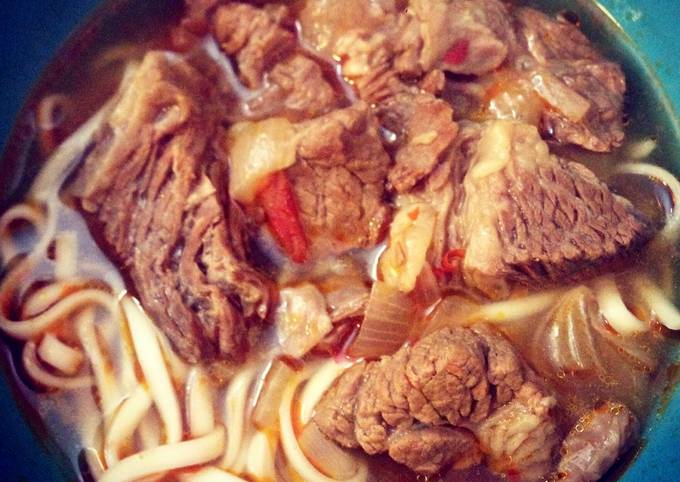Taiwanese Braised Beef Noodle Soup. Read Customer Reviews & Find Best Sellers. Taiwanese Beef Noodle Soup is so popular in Taiwan that some Taiwanese people refer to it as their national dish. Taiwan, an island off the coast of mainland China, has a rich culture and cuisine influenced by years of colonialism, migration and trade.
 Taiwan Red Cooked Beef Noodle Soup Beef noodle soup is virtually Taiwan's national dish.
This full-flavoured 'red braised' soup with succulent beef and silky noodles isn't hard to master at home (though it is time consuming).
Like most stocks, this one for beef noodles is hardly worth doing unless you do it in some volume.
You can cook Taiwanese Braised Beef Noodle Soup using 14 ingredients and 7 steps. Here is how you cook that.
Taiwan Red Cooked Beef Noodle Soup Beef noodle soup is virtually Taiwan's national dish.
This full-flavoured 'red braised' soup with succulent beef and silky noodles isn't hard to master at home (though it is time consuming).
Like most stocks, this one for beef noodles is hardly worth doing unless you do it in some volume.
You can cook Taiwanese Braised Beef Noodle Soup using 14 ingredients and 7 steps. Here is how you cook that.
Ingredients of Taiwanese Braised Beef Noodle Soup
- Prepare of boneless beef finger ribs.
- It's of medium onion.
- You need of red chili.
- Prepare of garlic.
- Prepare of peeled ginger.
- It's of green onion.
- You need of medium tomato.
- It's of seasoning for stewing 滷包 (star anise, clove, cinnamon, and nutmeg).
- It's of spicy chilli bean paste.
- You need of soy sauce.
- It's of rice wine.
- Prepare of Some pepper powder for seasoning.
- You need of Some cooking oil (vegetable oil or canola oil works fine).
- It's of Noodles to serve.
Braised Beef Noodle Soup (红烧牛肉面) This braised beef noodle soup used Chinese dry aromatics and beef with marbled fat making a delicious rich beef noodle soup that rivals restaurant versions! Taiwanese Beef Noodle Soup is a perfect orchestration of tender beef, a rich and slightly spicy broth, fresh noodles, a little bok choy, and that absolutely necessary fistful of Chinese pickled mustard greens and fresh scallions and cilantro. Flavored with warm spices, sugar and fermented broad bean chile paste, Taiwanese beef noodle soup is traditionally made with gelatinous beef shins and tendons, giving the broth a sticky richness The flavors and technique suit meaty short ribs, which come out meltingly tender and moist Adding a packet of powdered gelatin to the braising liquid gives it the same lip-sticking richness that. Braised beef noodle soup is only one of the many beef noodle variations, the broth has a darker color with red chili oil floating on top and fills the air with the smell of spices, perfect for this chilly weather.
Taiwanese Braised Beef Noodle Soup instructions
- Cut the beef into cubes of about 5 cm. I have also used different types of beef to make the beef noodles as finger ribs are not always available. I have used stewing beef (too lean and falls apart) and also beef flank (too fatty) before..
- Slice the onions, chop the chilli and green onions into smaller segments, slice the garlic and ginger, and chop the tomato..
- Heat up some water to blanch the cubes of beef..
- Boil just enough water to cover the beef in another pot with half of the green onion and ginger, and bag of seasoning. After boiling, place the cubes of beef into the pot and add the rice wine. Boil for about 3 minutes, take the beef out and set aside. Keep the remaining liquid and its contents..
- Warm up some oil in a wok and stir fry the onions, chilli, garlic, tomatoes, and the rest of the green onions and ginger. Then add the spicy chilli bean paste and the blanched beef from the previous step. Mix well..
- Add the remaining liquid and its contents from step 4 to the wok followed by soy sauce and pepper powder, boil, and simmer with lid on low heat for 2.5 hours. You can also use a pressure cooker to shorten the cooking time..
- Serve with cooked noodles..
A rich and hearty traditional Taiwanese beef stew. With house-made egg noodles and hearty flavors, our Braised Beef Soup is carefully cooked for hours to bring out its signature mildly spicy and aromatic flavors. Topped with blanched baby bok choy for a pop of color and crunch. This Taiwanese beef noodle soup will surely make your tummy rumble with its umami-rich soup base and nearly melt in the mouth braised beef. The hunger-inducing aroma is the result of the intermingling of a variety of Asian spices, aromatics, and herbs.